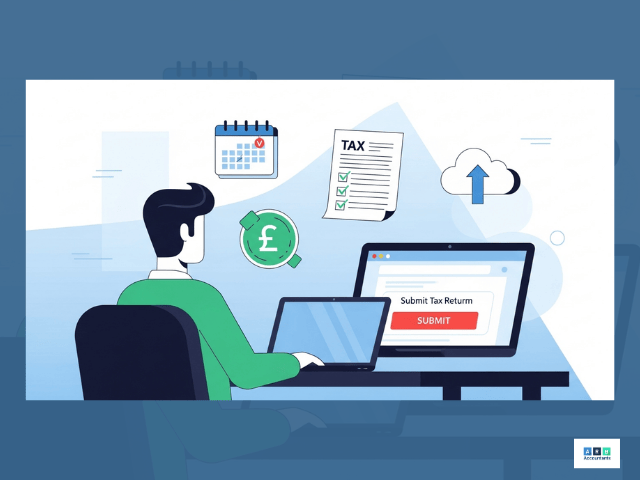
Sole Trader VAT Registration: When and How to Register
Running a business as a sole trader comes with responsibilities; VAT is one of them. If you’re approaching the VAT threshold UK 2024 or planning, understanding sole trader VAT registration is crucial.
Whether you’re freelancing, running an online store, or offering professional services, this guide breaks down when to register for VAT, how to do it, and what it means for your day-to-day operations.
What is VAT?
VAT (Value Added Tax) is a government-imposed tax on the sale of goods and services. In the UK, businesses must charge VAT once their taxable turnover exceeds a specific threshold, currently £90,000 over a rolling 12-month period. That means if your business income hits this mark, you must register with HMRC and start submitting VAT returns.
But sole trader VAT registration isn’t just a legal requirement. It’s also a decision that impacts your pricing, cash flow, and even how clients perceive your business. Many self-employed professionals choose to register voluntarily, especially when working with VAT-registered clients.
This guide is designed specifically for sole traders and freelancers seeking practical answers. We’ll walk you through how to register for VAT as a sole trader, using the official HMRC VAT registration guide, and highlight common pitfalls to avoid.
Why VAT Matters for Sole Traders
If you’re a self-employed individual, understanding sole trader VAT registration could mean the difference between compliance and penalties. Once your taxable turnover crosses the VAT threshold UK 2024 of £90,000, registering is no longer optional; it’s mandatory.
But beyond legality, there are strategic reasons VAT matters. For example, registering can make your business appear more established, particularly to corporate clients who expect to see VAT on invoices. If you’re a freelancer billing £3,000+ per project, voluntary UK VAT registration for self-employed professionals might even boost your credibility.
It also impacts how you price your services. VAT-registered clients can reclaim the VAT you charge, but individuals and non-VAT-registered businesses can’t. So, the cost of your services might feel higher unless you adjust your pricing or choose a scheme like the flat rate VAT option.
Simply put, understanding when to register for VAT helps you make smarter financial decisions as a sole trader.
READ RELATED ARTICLE: Is Your Business Due for a VAT Health Check?
When Do Sole Traders Need to Register for VAT?
Understanding when to register for VAT as a sole trader is essential to staying compliant and avoiding surprise penalties from HMRC. The rule is simple: if your taxable turnover exceeds £90,000 in a rolling 12-month period, VAT registration becomes mandatory. This threshold is set by the government and applies to all UK businesses, including the self-employed.
Mandatory VAT Registration: Hitting the £90,000 Threshold
As of the VAT threshold UK 2024, sole traders must track their taxable turnover, which includes most sales of goods or services that are not exempt from VAT. Once your income crosses the threshold at any point in a rolling 12 months (not just calendar or financial year), you must register within 30 days.
This is where many people get caught out. The rolling 12-month calculation means you must always look back, month by month, and not wait until year-end. If you delay sole trader VAT registration, you may be liable for backdated VAT, interest, and even penalties.
You can check whether you’ve crossed the limit using the HMRC VAT registration guide, which provides step-by-step help.
Voluntary Registration: Pros and Cons
Many freelancers and small business owners choose to register voluntarily, even if they haven’t yet hit the £90,000 mark. This might seem unnecessary, but it can offer strategic benefits.
Pros of voluntary registration:
- Professional credibility: Especially if your clients are larger businesses that expect VAT invoices.
- Claiming VAT: You can reclaim VAT on eligible business purchases like equipment, software, or travel.
- Preparation: You get used to handling VAT before it becomes a legal requirement.
Cons of voluntary registration:
- Administrative load: You’ll need to submit VAT returns quarterly.
- Cash flow concerns: You may need to charge clients more or pay VAT out of pocket if they can’t reclaim it.
- Pricing complexity: B2C clients may be discouraged by VAT-inclusive pricing.
For many, especially those offering services like consulting, design, or trades, early UK VAT registration for self-employed professionals can provide long-term benefits. But it’s important to weigh this against the added paperwork.
Exceptions and Edge Cases
There are a few exceptions and special situations to be aware of:
- If you temporarily go over the threshold but can prove it was a one-off, you might be exempt, but you’ll need to apply.
- Some services may be VAT-exempt or zero-rated (e.g., certain medical, educational, or financial services).
- If you only sell to VAT-registered businesses overseas, or if your work qualifies under the VAT for freelancers’ exemptions, different rules may apply.
In all cases, it’s best to consult an accountant or VAT specialist. Our sole trader tax tips section later in this guide shares how to avoid the common pitfalls and whether sole trader VAT registration is the right move for your business today.
How to Calculate Your Taxable Turnover
One of the most critical parts of sole trader VAT registration is knowing when to register for VAT, and that depends on accurately calculating your taxable turnover. Many sole traders miss the VAT threshold UK 2024 because they don’t realise what income counts toward it, or they’re not checking regularly enough.
This section walks you through what’s included in taxable turnover, what’s excluded, and how to use the rolling 12-month method to stay compliant with HMRC VAT registration guide rules.
What Counts Towards Taxable Turnover?
Taxable turnover includes the total value of everything you sell that is not exempt from VAT. If you’re a freelancer, consultant, designer, tradesperson, or any other self-employed professional, your invoices for goods or services will likely count.
Include the following:
- Sales of standard and reduced-rated goods or services
- Services provided to UK clients
- Zero-rated supplies (e.g., some foods, books, children’s clothing, still taxable at 0%)
- Goods hired or loaned to customers
- Business assets sold
- Commission or agency fees
If you’re following sole trader tax tips from your accountant, you’ve likely been advised to keep detailed income records. This helps when reviewing whether your taxable turnover is approaching the threshold.
For many UK VAT registration for self-employed professionals, especially in service-based industries, it’s easy to underestimate income when split across multiple clients or jobs.
What Doesn’t Count?
Not everything you earn as a sole trader contributes to the VAT threshold:
- VAT-exempt sales (e.g, most insurance, education, finance services)
- Sales of capital assets (if VAT wasn’t charged)
- Income from outside your business (e.g., personal investments or loans)
- Disbursements where you pay expenses on behalf of clients
These exclusions are important, especially if you work across sectors. For example, VAT for freelancers in healthcare or education may include exempt services. That said, be cautious: HMRC may challenge misclassifications, and incorrect exclusions can result in penalties.
The Rolling 12-Month Total Explained
One of the biggest misconceptions around sole trader VAT registration is how turnover is measured. It’s not based on your calendar year or tax year. HMRC requires you to use a rolling 12-month period, which means checking your total income at the end of each month by looking back at the previous 12 months.
Let’s say you earned £8,000 in July 2023, £9,000 in August, £10,000 in September, and so on. Each month, you recalculate your cumulative income over the past 12 months. The moment your taxable turnover exceeds £90,000, you have 30 days to complete your sole trader VAT registration.
For example, if your turnover hits £91,000 on 10 July 2024, you must register for VAT by 9 August 2024. Your effective VAT start date will likely be 1 September (or earlier if you choose).
HMRC offers a calculator and flowchart in their HMRC VAT registration guide, but many sole traders find it easier to use a spreadsheet or accounting software to automate this.
READ RELATED ARTICLE: How to Make a Voluntary Disclosure to HMRC
How to Register for VAT as a Sole Trader
Once you’ve crossed the VAT threshold UK 2024 or decide to register voluntarily, it’s time to complete your sole trader VAT registration. Thankfully, the process is entirely online and managed through HMRC. That said, many sole traders delay or make errors during registration simply because they don’t know what to expect.
This section offers a clear, step-by-step guide on how to register for VAT as a sole trader, the documents you’ll need, and what happens next.
Step-by-Step: Registering with HMRC
1. Create a Government Gateway account (if you don’t have one):
You’ll need a personal or business HMRC account to begin the VAT registration process. You can set one up at gov.uk if you’re not already registered.
2. Go to the VAT registration portal:
Access the VAT application via the official HMRC VAT registration guide. You’ll be prompted to log in using your Government Gateway credentials.
3. Start your application:
You’ll be asked whether you’re registering as an individual sole trader. Confirm your business type to proceed.
4. Enter required business details:
This includes your name, trading name, business address, and contact info. Be precise; errors here can delay your VAT number.
5. Provide your Unique Taxpayer Reference (UTR):
This is your 10-digit UTR issued by HMRC when you registered as self-employed. It connects your VAT account to your tax records.
6. Provide your National Insurance Number (NI):
This helps verify your identity and ensures your VAT profile is linked to your existing self-assessment account.
7. Declare your business activities and turnover:
You’ll need to state your taxable turnover (whether it’s over or under £90,000) and the nature of your services; this is key for many VAT for freelancers and service-based trades.
8. Select your preferred VAT scheme:
You can opt for the standard VAT scheme or alternatives like the flat rate scheme or cash accounting (more on this later in the guide).
9. Submit your application:
Once submitted, HMRC will review your information and process your application. Keep a copy of the confirmation page.
What You’ll Need to Register
To make the sole trader VAT registration process smooth, gather these in advance:
- Government Gateway ID and password
- Your UTR (Unique Taxpayer Reference)
- Your National Insurance Number
- Business address and contact details
- Date you exceeded the threshold or intend to register
- Business activity description (e.g., freelance marketing, plumbing, ecommerce)
For UK VAT registration for self-employed professionals, providing accurate and clear information reduces the chances of rejection or delay.
What Happens After You Register?
Once HMRC approves your application, you’ll receive a VAT registration certificate, typically within 2–4 weeks.
This includes:
- Your VAT number
- Effective date of registration
- First VAT return and payment due date
From that point, you must:
- Start charging VAT on eligible invoices
- Display your VAT number on all invoices
- Keep VAT records and submit quarterly returns
If you registered voluntarily, your effective date might be backdated, so it’s essential to know when to register for VAT and keep clean records to avoid reclaim issues later.
You’ll also need to choose how to file your returns, via an accountant, accounting software, or directly through the HMRC VAT registration guide platform.
After Registration: What’s Next?
Completing your sole trader VAT registration is only the beginning. Once HMRC confirms your registration and sends you a VAT number, you’ll need to update how you run your business. From charging VAT correctly to submitting returns on time, the admin doesn’t stop after hitting the VAT threshold UK 2024.
This section outlines the key actions you need to take next, including invoicing properly, choosing the right VAT scheme, and keeping up with VAT return deadlines. If you’re still wondering how to manage it all as a self-employed person, these are essential sole trader tax tips.
Charging VAT on Goods or Services
Once your sole trader VAT registration is active, you’re legally required to charge VAT on all taxable sales from your effective registration date. The standard rate is 20%, but some items may fall under reduced (5%) or zero-rated (0%) categories.
If you send an invoice without VAT after registering, HMRC may still expect you to account for the VAT, even if you didn’t charge it. So it’s crucial to review your pricing and update your invoicing system as soon as you’re registered.
If you’re unsure when to register for VAT and how it affects current or backdated invoices, consult the HMRC VAT registration guide or speak with an accountant.
Invoicing Properly as a VAT-Registered Sole Trader
VAT invoices must follow specific guidelines to remain compliant. Each invoice should include:
- Your business name and address
- Your VAT number
- Invoice date and unique invoice number
- Description of goods or services
- The VAT rate charged (e.g., 20%)
- Total amount before VAT, the VAT added, and the grand total
For UK VAT registration for self-employed professionals who use invoicing tools or accounting software, ensure to turn on VAT settings after you receive your number. Manual invoices should be double-checked to include all required elements.
Choosing the Right VAT Scheme
Sole traders have options when it comes to how they calculate and report VAT. HMRC offers different schemes based on your turnover, industry, and how you manage cash flow.
1. Standard VAT Accounting Scheme:
You charge VAT on sales and reclaim it on purchases. Returns are usually filed quarterly. This is the default scheme after sole trader VAT registration.
2. Flat Rate Scheme:
You charge VAT at the standard rate but pay HMRC a lower, fixed percentage of your turnover. You cannot reclaim VAT on purchases (with a few exceptions). This is popular with freelancers and microbusinesses.
3. Cash Accounting Scheme:
You only pay VAT once your clients pay you. Similarly, you reclaim VAT on purchases only after you’ve paid your suppliers. Ideal if you deal with late payments.
Choosing the right scheme depends on your business model. The HMRC VAT registration guide offers a breakdown of each option, but it’s best to get advice tailored to your situation.
Submitting VAT Returns
Once registered, you’ll usually need to submit VAT returns every quarter. This involves reporting:
- VAT you’ve charged on sales (output tax)
- VAT you’ve paid on purchases (input tax)
- The amount you owe or can reclaim
Returns must be submitted online using Making Tax Digital (MTD) compliant software. Late submissions or payments can result in penalties and interest.
For many, this is the most challenging part of sole trader VAT registration. It’s also why many VAT for freelancers guides recommend using an accountant or MTD-ready software from day one.
Need Help? Speak to a VAT Specialist
Struggling with sole trader VAT registration or unsure when to register for VAT? You’re not alone. At ARB Accountants, we help self-employed professionals handle VAT the right way from checking if you’ve crossed the VAT threshold UK 2024 to filing returns and choosing the right scheme, all with the support of trusted local accountants for self assessment.
If you’re unsure how to proceed, speak to a VAT expert who knows UK VAT registration for self-employed inside out. Book a free consultation today, and avoid costly mistakes later.






